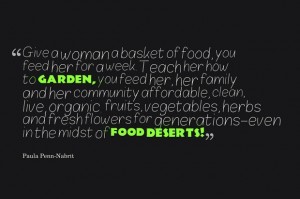
Philanthropy is the new marketing. Take food activism. Our media team learned this lesson the hard way. This summer we launched a campaign to set up an urban garden, actually a mini-farm, called the Charles Madison Nabrit Memorial Garden on the indiegogo.com, a crowdsourcing platform.
Our team chose this particular project because we wanted to devote our efforts to an environmental or green cause for our social impact project. What could be better than helping to build a mini-farm or fixing a ‘food desert’ in Middle America (Columbus, OH.)?
A story from Paula Penn-Nabrit (Wellesley ’76), garden founder, food activist, and my seven-sister college sibling, made a compelling case as she outlined the importance of learning to grow and preserve our own food during these trying times of hunger and poverty in America.
“If growing your own food is like printing your own money, then preserving your own food is like saving your hard earned cash!” said Penn-Nabrit.
By now, the Charles Madison Nabrit Memorial Garden, named for Paula’s husband, has made great strides. They had raised $5000 of a $10,000 campaign. But they still need more money. They need fencing to keep deers and critters out. And, they are getting ready for a robust harvest, farmer’s market and community classes.

‘Marketing’ your stories to your friends with the hope that they will participate and share with others unknown to you is a challenge. But it is a strategy that works. Like a garden, it takes time and constant tweaking.
A recent article in Philanthropy.com by Paul Van DeCarr explores how philanthropy is the new marketing and some tips to consider.
“How do we create or “market” stories so they’ll appeal to people other than those who already support us; so they’ll reach people who may be unfamiliar with our issue or even disagree with us? We’ve all been there before—with documentary-film screenings, story-sharing websites, or social-change plays that preach to the converted. To enlarge your audience, sometimes all you need to do is activate people who are sympathetic, but inactive. Or, you may sometimes want to engage people who aren’t already on board. As for engaging people who disagree with you, often times the best you can hope for is to neutralize their opposition.”
Consider the following principles to build your base through storytelling. Click on this link.
Want to solve hunger and poverty in Middle America? Contribute here to the Charles Madison Nabrit Memorial Garden.
Is philanthropy the new marketing in your life’s work?
